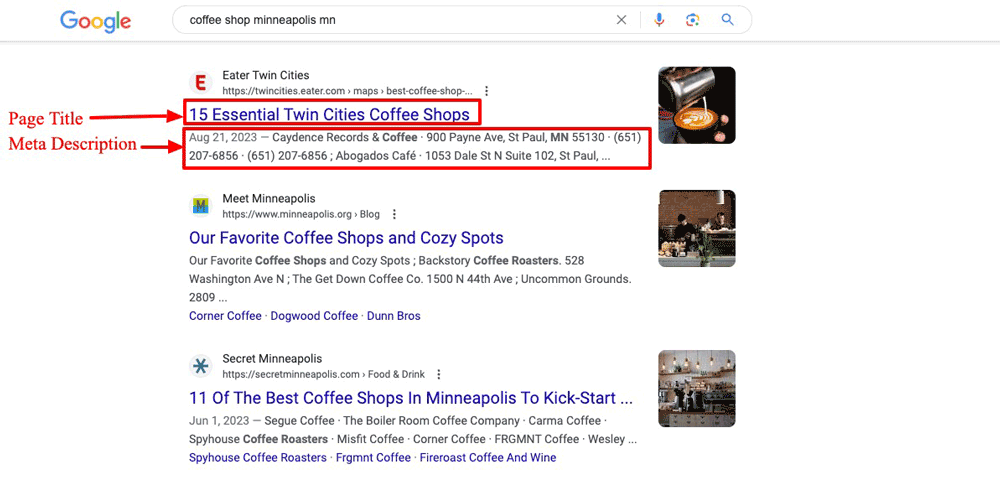Welcome to our Free SEO Page Title & Meta Description Length Testing Tool!
Elevate your SEO strategy and skyrocket your click-through rates with our user-friendly tool. Optimize your content for better results in just a few clicks!
Page Title & Meta Description Length Checker
Place your text below in the two boxes. Then test the length by clicking the button "test length"! 😊
Recommended page title length: 50-60 characters.
Recommended meta description length: 160 characters.
Table of Contents
How to Check Your Page Title for SEO
Making Sure Your Page Title is Search Engine Friendly
Your page title, also known as the “title tag,” is super important for SEO. It’s what shows up as the clickable link when your page appears in search results. To check and improve your page titles, follow these easy steps:
1. Open Your Page:
First, go to the web page you want to check. You can do this by going to your website or using your website editor.
2. Look at Your Browser’s Title:
Check the title that shows up in the top of your web browser. That’s the title your visitors see when they’re on your page.
3. Peek at the HTML:
To get a closer look, right-click anywhere on your page and choose “View Page Source” or “Inspect.” This opens up the page’s HTML code.
4. Find the Title Tag:
In the HTML code, hunt for the <title> tag. It’s usually in the <head> section. The text inside this tag is what search engines use as your page’s title.
5. What’s Inside? Check It:
The words inside the <title> tag are what shows up as your page’s title in search results. Make sure it’s on-topic, descriptive, and includes the keywords you want to target.
6. Keep It Short:
Try to keep your title between 50 and 60 characters. Titles that are too long might get cut off in search results, which isn’t ideal. Test Page Title Length.
7. Keywords Matter:
Use keywords that match what’s on your page. These keywords should tell people what your page is about.
8. Make It Click-Worthy:
Your title is the first thing people see in search results. Make it interesting and convincing, so folks want to click on your link.
9. No Copy-Paste Titles:
Each of your pages should have a unique title. Avoid using the same title for multiple pages; it can get confusing.
10. Test it Out:
After you make any changes, do a quick search to see how your title looks in the search results. This helps you make sure it’s appealing and helpful for users.
By following these steps, you can be sure that your page titles are doing their job for SEO. An effective title can boost your site’s visibility and get more people to click on your links in search results. It’s all about helping users find your awesome content!
How to Check Your Meta Description
Understanding and Optimizing Meta Descriptions for SEO
A meta description serves as a concise preview of your web page’s content, visible in search results. To ensure it performs optimally, follow these straightforward steps:
1. Dive into the HTML Source:
Begin your journey by accessing your web page’s HTML source, which can be done through your website editor or by directly manipulating the HTML code.
2. Locate the Meta Description Tag:
Within the HTML code, identify the <meta name="description"> tag situated within the <head> section. This is where your meta description resides.
3. Examine the Meta Description Content:
Inside the <meta name="description"> tag, you’ll encounter your meta description. It should be succinct and effectively communicate your page’s essence. Incorporate pertinent keywords for context.
4. Ensure Proper Length:
Maintain a description under 160 characters to prevent truncation in search results. Test Meta Description Length.
5. Utilize Relevant Keywords:
Embed keywords that precisely mirror your webpage’s subject matter. These are the key terms people may search for.
6. Create an Engaging Description:
Your meta description acts as a teaser, enticing users to click. Make it captivating and informative, motivating individuals to explore your content.
7. Avoid Duplicate Descriptions:
Each webpage should feature a unique meta description. Steer clear of duplication to prevent confusion in search results.
8. Harness SEO Tools:
Leverage specialized tools and plugins for further refinement. They provide valuable insights and optimization suggestions.
9. Preview and Adjust:
Before finalizing, use a tool that illustrates how your meta description will appear in search results. This enables last-minute adjustments.
10. Monitor and Adapt:
SEO is a dynamic process. Regularly assess your meta descriptions with analytical tools to gauge click-through rates. Adapt and refine as needed.
By adhering to these steps, you can ensure that your meta descriptions efficiently fulfill their role, enhancing your website’s visibility in search results. Ultimately, it’s about enticing users to click and explore your valuable content.
10 frequently asked questions (FAQs) related to the SEO Page Title & Meta Description Length Checker tool:
1. What is the purpose of this tool?
This tool helps you check the length of your page title and meta description to ensure they are optimized for SEO.
2. Why is it important to optimize page titles and meta descriptions?
Optimized page titles and meta descriptions can improve search engine rankings and attract more clicks to your website.
3. What are the recommended character limits for page titles and meta descriptions?
We recommend a page title length of 50-60 characters and a meta description length of up to 160 characters.
4. How does this tool work?
Simply enter your page title and meta description, and click the “Test Length” button. The tool will provide feedback on whether they meet the recommended lengths.
5. What should I do if my content exceeds the recommended limits?
If your content is too long, the tool will indicate the excess characters. You should consider revising your title or description to fit within the limits.
6. Can I include my target keyword in the analysis?
Yes, you can enter your target keyword, and the tool will check if it’s included in the URL, page title, and meta description. It will provide feedback if the keyword is missing.
7. Is this tool free to use?
Yes, this tool is completely free to use. There are no hidden charges or subscriptions required.
8. Can I use this tool for multiple pages on my website?
Absolutely! You can use this tool for any page on your website to ensure consistent optimization.
9. How can I improve my SEO based on the results from this tool?
If your page title and meta description don’t meet the recommended lengths or if your keyword is missing, consider making adjustments to enhance your SEO.
10. Are there any additional SEO tips you can provide?
Beyond length and keywords, focus on creating high-quality, relevant content and obtaining backlinks to improve your website’s SEO performance.




0 Comments